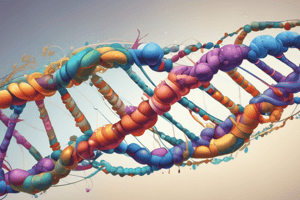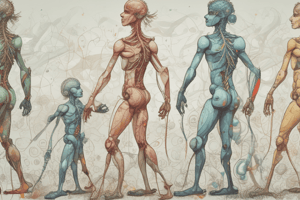Podcast
Questions and Answers
What was the primary purpose of Charles Darwin's voyage on the HMS Beagle?
What was the primary purpose of Charles Darwin's voyage on the HMS Beagle?
- To explore the fossil beds of South America
- To collect flora and fauna from various continents and islands (correct)
- To study the finch species on the Galapagos Islands
- To develop a theory of how species change over time
What was a notable observation made by Darwin during his voyage?
What was a notable observation made by Darwin during his voyage?
- Fossils resembled but were not identical to living organisms in the same area (correct)
- Finch species on the Galapagos Islands were identical to each other
- The Beagle's voyage was limited to South America
- Fossils were identical to living organisms in the same area
What was a significant difference observed by Darwin among finch species on the Galapagos Islands?
What was a significant difference observed by Darwin among finch species on the Galapagos Islands?
- They were only found on one island
- They had small but significant differences (correct)
- They were all identical to each other
- They had identical beak shapes and sizes
What was the name of the ship on which Charles Darwin embarked on his five-year voyage?
What was the name of the ship on which Charles Darwin embarked on his five-year voyage?
How long did Charles Darwin's voyage on the HMS Beagle last?
How long did Charles Darwin's voyage on the HMS Beagle last?
What was a key area of focus for Charles Darwin during his voyage?
What was a key area of focus for Charles Darwin during his voyage?
What was a result of Darwin's observations during his voyage?
What was a result of Darwin's observations during his voyage?
Where did Charles Darwin collect finch species that showed small but significant differences?
Where did Charles Darwin collect finch species that showed small but significant differences?
What is the name of the lecturer who presented this material?
What is the name of the lecturer who presented this material?
What is the date on which Kofi Owusu-Daaku delivered this lecture?
What is the date on which Kofi Owusu-Daaku delivered this lecture?
Flashcards are hidden until you start studying
Study Notes
Origin of Life
- In 1953, Miller conducted experiments on molecular evolution, exposing a mixture of H2, CH4, NH3, and H2O to high electric discharge, resulting in the formation of advanced molecules, including CO, CO2, N2, and amino acids like glycine and valine.
- The experiment led to the formation of a liquid condensate phase, including a variety of amino acids and other organic molecules.
- During this period, certain compounds that favored molecular evolution survived, while those that disfavored it were destroyed by predator molecules like hydrated electrons and poly anions.
- The culmination of chemical evolution was the polymerization of monomers, resulting in the formation of biopolymers like proteins, polysaccharides, lipids, and polynucleotides.
- Certain polymers like histones and protamines, which are positively charged, enclosed polynucleotides, protecting them from predator molecules.
Tracer Carbon Technique
- The hypothesis was confirmed by the tracer carbon technique and chromatographic identification of the products (Arnon, 1960).
Evolution of Chlorophyll
- The evolution of the chlorophyll molecule was a landmark in the origin of photosynthetic life, as it is capable of emitting electrons when excited by radiant energy.
- The evolution of photosynthetic life could change the reducing environment to an oxidizing one due to the release of oxygen.
Atmosphere and Land Mass
- At the time of the origin of animals, the atmosphere contained N2, CO2, and O2 gases, while the land mass contained soil rich in soluble nitrates, sulfates, phosphates, and organic materials.
Lamarckism
- Jean Baptiste de Lamarck (1744-1829) proposed the theory of inheritance of acquired characters, also known as the "Theory of Use or Disuse of Organs".
- According to Lamarck's theory, as giraffes stretched to reach high branches, their necks lengthened, and this was passed on to their offspring.
- The basic ideas of Lamarckism are:
- Complex plants and animals are produced from simpler ones over time under the influence of nature.
- Living organisms have a tendency to continuously increase in size.
- There is a change in the needs of an animal due to changes in the surrounding environment, leading to the formation of new organs.
- If an organ is used continuously, it becomes more powerful, and if it is not used for a long time, it weakens and eventually disappears.
- The characters acquired during the lifetime of individuals are transmitted to the next generation.
Critical Analysis
- Lamarck based his idea of use and disuse on the evidence of vestigial organs and rudimentary organs.
- The idea is true, but it cannot be treated as a basis of evolution.
- Weismann (1890) provided experimental proof against the theory of inheritance of acquired characters, showing that changes in germ cells are inherited, not somatic changes.
Neo-Lamarckism
- A few scientists, including Herbert Spencer, Haeckel, and Gadow, have supported Lamarckism in a modified form, known as Neo-Lamarckism.
Charles Darwin
- Charles Darwin joined a sea voyage on the HMS Beagle, collecting flora and fauna from many continents and islands.
- Darwin noted unexpected patterns among fossils and living organisms, leading to the development of his theory of how species might change over time.
- Fossils resembled but were not identical to living organisms in the same area where they were found.
- Finch species on each of the Galapagos Islands differed from each other in small but significant ways.
Studying That Suits You
Use AI to generate personalized quizzes and flashcards to suit your learning preferences.




